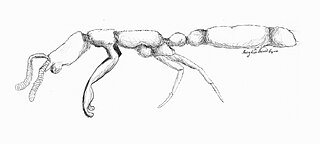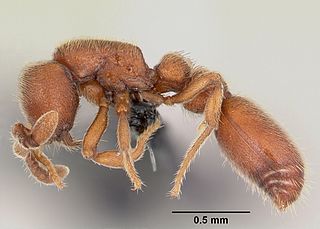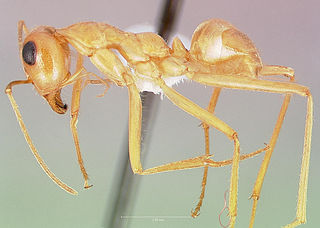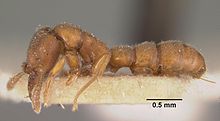
Ants are eusocial insects of the family Formicidae and, along with the related wasps and bees, belong to the order Hymenoptera. Ants evolved from vespoid wasp ancestors in the Cretaceous period. More than 13,800 of an estimated total of 22,000 species have been classified. They are easily identified by their geniculate (elbowed) antennae and the distinctive node-like structure that forms their slender waists.

Trophallaxis is the transfer of food or other fluids among members of a community through mouth-to-mouth (stomodeal) or anus-to-mouth (proctodeal) feeding. Along with nutrients, trophallaxis can involve the transfer of molecules such as pheromones, organisms such as symbionts, and information to serve as a form of communication. Trophallaxis is used by some birds, gray wolves, vampire bats, and is most highly developed in eusocial insects such as ants, wasps, bees, and termites.

Yellowjacket or yellow jacket is the common name in North America for predatory social wasps of the genera Vespula and Dolichovespula. Members of these genera are known simply as "wasps" in other English-speaking countries. Most of these are black and yellow like the eastern yellowjacket and the aerial yellowjacket ; some are black and white like the bald-faced hornet. Some have an abdomen with a red background color instead of black. They can be identified by their distinctive markings, their occurrence only in colonies, and a characteristic, rapid, side-to-side flight pattern prior to landing. All females are capable of stinging. Yellowjackets are important predators of pest insects.

Myrmecia is a genus of ants first established by Danish zoologist Johan Christian Fabricius in 1804. The genus is a member of the subfamily Myrmeciinae of the family Formicidae. Myrmecia is a large genus of ants, comprising at least 93 species that are found throughout Australia and its coastal islands, while a single species is only known from New Caledonia. One species has been introduced out of its natural distribution and was found in New Zealand in 1940, but the ant was last seen in 1981. These ants are commonly known as bull ants, bulldog ants or jack jumper ants, and are also associated with many other common names. They are characterized by their extreme aggressiveness, ferocity, and painful stings. Some species are known for the jumping behavior they exhibit when agitated.

The name army ant (or legionary ant or marabunta) is applied to over 200 ant species in different lineages. Because of their aggressive predatory foraging groups, known as "raids", a huge number of ants forage simultaneously over a limited area.

The Eucharitidae are a family of parasitic wasps. Eucharitid wasps are members of the superfamily Chalcidoidea and consist of four subfamilies: Akapalinae, Eucharitinae, Gollumiellinae, and Oraseminae. Most of the 42 genera and >400 species of Eucharitidae are members of the subfamilies Oraseminae and Eucharitinae, and are found in tropical regions of the world.

Nothomyrmecia, also known as the dinosaur ant or dawn ant, is an extremely rare genus of ants consisting of a single species, Nothomyrmecia macrops. These ants live in South Australia, nesting in old-growth mallee woodland and Eucalyptus woodland. The full distribution of Nothomyrmecia has never been assessed, and it is unknown how widespread the species truly is; its potential range may be wider if it does favour old-growth mallee woodland. Possible threats to its survival include habitat destruction and climate change. Nothomyrmecia is most active when it is cold because workers encounter fewer competitors and predators such as Camponotus and Iridomyrmex, and it also increases hunting success. Thus, the increase of temperature may prevent them from foraging and very few areas would be suitable for the ant to live in. As a result, the IUCN lists the ant as Critically Endangered.

The green-head ant is a species of ant that is endemic to Australia. It was described by British entomologist Frederick Smith in 1858 as a member of the genus Rhytidoponera in the subfamily Ectatomminae. These ants measure between 5 and 7 mm. The queens and workers look similar, differing only in size, with the males being the smallest. They are well known for their distinctive metallic appearance, which varies from green to purple or even reddish-violet. Among the most widespread of all insects in Australia, green-head ants are found in almost every Australian state, but are absent in Tasmania. They have also been introduced in New Zealand, where several populations have been established.
Larval hemolymph feeding is a behaviour trait found in the queens of some species of ant. This is found mainly in the ants of the subfamily Amblyoponinae and give them the other name of Dracula ant. In colonies of the Amblyopone silvestrii the queens feed on the hemolymph of their larvae when food is not available. In one species, Myopopone castanea, worker ants consume larval hemolymph. This is said to be a precursor to trophallaxis in other ant families. The larvae themselves are not killed by this process. This behaviour is also seen in Proceratium and in Leptanilla the larvae have special organs that exude the haemolymph. On the other hand, the foundresses suppress larval hemolymph feeding (LHF) when prey is available, allowing them to rear the first workers more swiftly. The nondestructive form of cannibalism can be regarded as a nutritive adaptation related to: (1) the lack of social food transfer in this species, and (2) its specialized predation on large sporadic prey (centipedes). LHF similar to that in Amblyopone was found in Proceratium and another type of LHF, with a larval specialized exudatory organ, in Leptanilla.

Ochetellus glaber is a species of ant native to Australia. A member of the genus Ochetellus in the subfamily Dolichoderinae, it was described by Austrian entomologist Gustav Mayr in 1862. Aside from Australia, O. glaber has been introduced to a number of countries, including China, India, Japan, New Zealand, the Philippines and the United States, where it has established itself in Hawaii and Florida. It has been found on Lord Howe Island, New Caledonia, Norfolk Island, Réunion, New Zealand, and the Solomon Islands. Compared with other ants, O. glaber is a small species, with workers measuring 2–3 mm (0.079–0.118 in). Males are the smallest at 1.6 mm (0.063 in), while the queens measure 5.2–5.5 mm (0.20–0.22 in). The ant's colour ranges from brown to black.

Leptanilla japonica is an uncommon highly migratory, subterranean ant found in Japan. They are tiny insects, with workers measuring about 1.2 mm and queens reaching to about 1.8 mm, and live in very small colonies of only a few hundred individuals at a time Its sexual development follows a seasonal cycle that affects the colony's migration and feeding habits, and vice versa. L. japonica exhibits specialized predation, with prey consisting mainly of geophilomorph centipedes, a less reliable food source that also contributes to their high rate of nest migration. Like ants of genera Amblyopone and Proceratium, the genus Leptanilla engages in larval hemolymph feeding (LHF), with the queen using no other form of sustenance. LHF is an advantageous alternative to the more costly cannibalism. Unlike any other ant, however, members of Leptanilla, including L. japonica, have evolved a specialized organ dubbed the “larval hemolymph tap” that reduces the damage LHF inflicts on the larvae. LHF has become this species' main form of nutrition.

Ooceraea biroi, the clonal raider ant, is a queenless clonal ant in the genus Ooceraea. Native to the Asian mainland, this species has become invasive on tropical and subtropical islands throughout the world. Unlike most ants, which have reproductive queens and mostly nonreproductive workers, all individuals in a O. biroi colony reproduce clonally via thelytokous parthenogenesis. Like most dorylines, O. biroi are obligate myrmecophages and raid nests of other ant species to feed on the brood.

Myrmecocystus mexicanus is a species of ant in the genus Myrmecocystus, which is one of the six genera that bear the common name "honey ant" or "honeypot ant", due to curious behavior where some of the workers will swell with liquid food until they become immobile and hang from the ceilings of nest chambers, acting as living food storage for the colony. Honey ants are found in North America, Australia, and Africa. Ant species belonging to the genus Myrmecocystus reside in North America. M. mexicanus in particular is found in the southwestern United States and parts of Mexico.

Ochetellus is a genus of ants first described by Steve Shattuck in 1992. He placed it in the subfamily Dolichoderinae of the family Formicidae. The ants in this genus are small and black in colour; workers measure 1.75 to 3 millimetres in length, the males at around 1.6 millimetres (0.06 in) are smaller, and the queens are the largest, reaching 4 millimetres (0.16 in). There are seven described species and three described subspecies that mostly live in Australia in a wide variety of habitats, but some species are found in Asia. One species, Ochetellus glaber, has been introduced into New Zealand and the United States.

Myrmecia regularis is a species of ant endemic to Australia. A member of the genus Myrmecia in the subfamily Myrmeciinae, it was first described by American entomologist Walter Cecil Crawley in 1925. These ants are medium to large in size, measuring 10 to 20 millimetres, and they are bright brownish-red in colour. Queens and workers share similar morphological features, but they can be distinguished by the noticeable size difference. Males also look similar, but collected specimens are too damaged to be examined properly.
Mycocepurus castrator is a species of parasitic ant, in the genus Mycocepurus, native to Brazil. Described in 2010, the species is a workerless and obligate parasite of the related ant Mycocepurus goeldii. It is known only from Rio Claro, Brazil, and has only been found in nests of M. goeldii.

Polistes bellicosus is a social paper wasp from the order Hymenoptera typically found within Texas, namely the Houston area. Like other paper wasps, Polistes bellicosus build nests by manipulating exposed fibers into paper to create cells. P. bellicosus often rebuild their nests at least once per colony season due to predation.
This is a glossary of terms used in the descriptions of ants.

Novomessor ensifer is a species of ant endemic to Mexico. A member of the genus Novomessor in the subfamily Myrmicinae, it was first described by Swiss entomologist Auguste Forel in 1899. N. ensifer was originally a part of the genus Aphaenogaster until a recent phylogenetic study concluded that Novomessor was genetically distinct and should be separated. The ant is a medium-sized species, measuring 5.5 to 10 millimetres. The ant is ferruginous-colored in some certain parts of the body, and small workers (nanitics) in incipient colonies are noticeably different in color and body structure.

Amblyopone australis, the southern Michelin ant, is a species of ant in the genus Amblyopone, native to Australia. The species was described by Wilhelm Ferdinand Erichson in 1842. Workers can vary in colour from yellow to dark brown or black. They have a body length of 4.5–8mm; queens are larger.

















